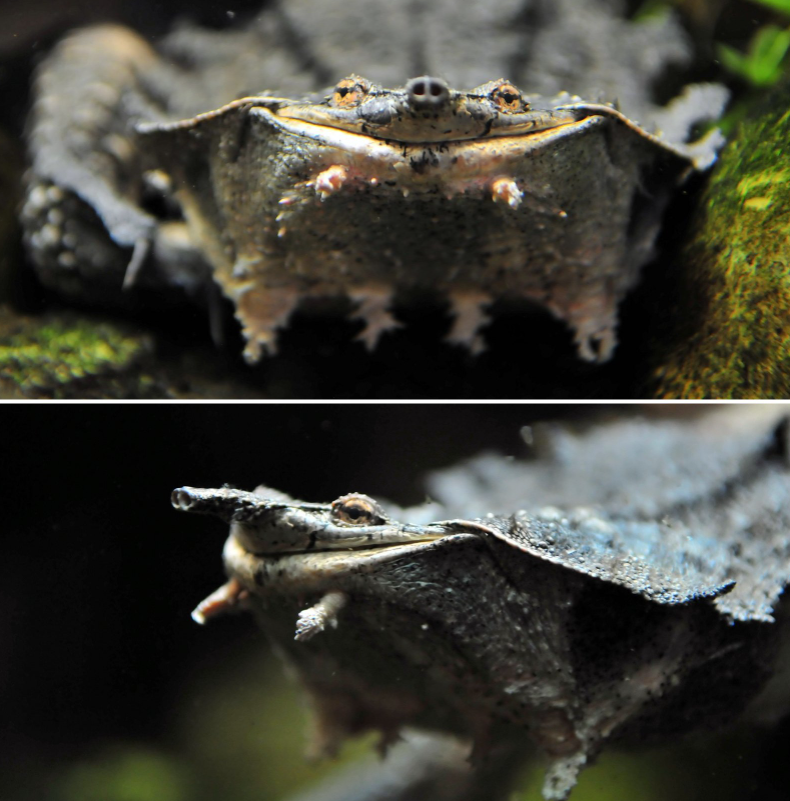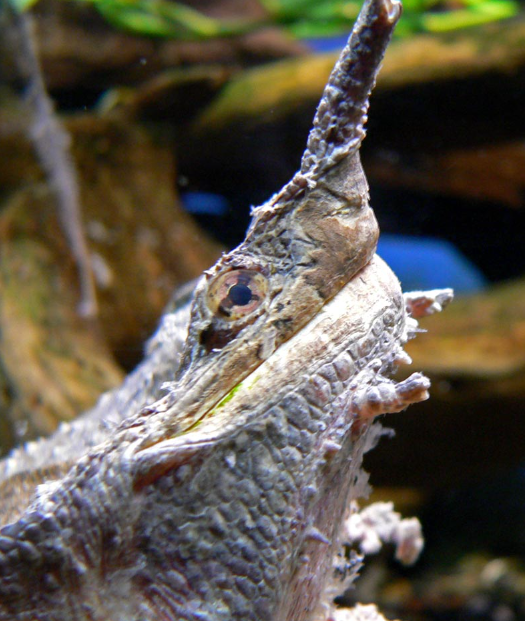The animal kingdom is home to a wide array of incredible creatures, but few are as strange and captivating as the mata mata turtle. With its bizarre appearance and almost comical grin, this freshwater turtle from South America has fascinated researchers and animal enthusiasts alike. Its prehistoric look, coupled with its unusual behavior, makes it one of nature’s most enigmatic creatures.
Living in the murky waters of the Amazon and Orinoco river basins, the mata mata turtle has developed some of the most remarkable adaptations for survival. From its impeccable camouflage to its incredible suction feeding technique, the mata mata is a master of blending in and catching prey in its aquatic environment.
In this article, we’ll dive deep into what makes this turtle so extraordinary, from its physical traits to its hunting methods, and why it continues to capture the curiosity of nature lovers worldwide.

A Unique Appearance: Evolution’s Strange Masterpiece
At first glance, the mata mata turtle might look like something out of a fantasy novel. Its broad, flat head is covered in rough, wart-like skin and flaps, giving it the appearance of a piece of decaying bark or plant material. This odd-looking shell provides the perfect camouflage for the turtle, helping it blend seamlessly into its natural surroundings.
Its neck, long and fringed with skin flaps, adds to its unusual appearance. These flaps not only make it look like debris floating in the water but also serve a vital sensory function. The mata mata uses them to detect changes in water movement, allowing it to sense when potential prey or predators are nearby. Though its head may appear too large for its body, the mata mata is perfectly built for the slow, quiet waters of its home.
One of the turtle’s most striking features is its ever-present smile. Despite its odd appearance, the mata mata seems to be perpetually grinning, which has endeared it to those who study or encounter it in the wild. But make no mistake—beneath that seemingly friendly smile lies an expert predator.
Expert Camouflage: Disappearing into the Background
In the wild, blending in with your surroundings is often key to survival. The mata mata takes this to the extreme, with its shell, skin, and overall body structure designed to mimic the appearance of debris floating in the water. Covered in algae and aquatic plants, its body becomes almost indistinguishable from the fallen leaves, bark, and branches that clutter the rivers it inhabits.

This natural camouflage serves a dual purpose. First, it helps the mata mata avoid predators. Though the turtle has few natural enemies, larger aquatic predators, such as crocodiles or large fish, may occasionally pose a threat. Its ability to blend into the environment keeps it safe from being noticed.
But perhaps even more importantly, its camouflage makes the mata mata a highly effective ambush predator. By blending in with its surroundings, the turtle can remain perfectly still, waiting for unsuspecting prey to swim by. Its patience and stealth are key components of its hunting success.
The Mata Mata’s Fascinating Hunting Technique
Unlike most turtles that rely on their sharp beaks or strong jaws to capture and eat prey, the mata mata has developed a far more sophisticated hunting method—suction feeding. This technique is both efficient and effective, allowing the turtle to capture its prey with lightning speed and minimal effort.
When an unsuspecting fish or small aquatic creature swims too close, the mata mata opens its large, gaping mouth and, in an instant, creates a vacuum. The sudden drop in pressure sucks both water and prey into the turtle’s mouth, where it is swallowed whole. The mata mata does not chew its food; instead, it expels the excess water and swallows its meal in a single gulp. This feeding strategy requires no chase or struggle, making it an energy-efficient way to capture food.

Interestingly, the mata mata turtle uses its neck and body to help herd prey into its strike zone. By positioning itself in shallow water or among aquatic vegetation, it can effectively guide small fish or invertebrates toward its mouth. The precision with which it hunts demonstrates its evolutionary success as an ambush predator.
Habitat and Distribution: The Amazon and Orinoco Basins
The mata mata turtle is native to the slow-moving, shallow waters of the Amazon and Orinoco river systems in South America. It thrives in regions where the water is still or only gently flowing, such as swamps, ponds, and marshes. These waters are typically murky and filled with vegetation, providing the perfect backdrop for the turtle’s camouflage and hunting methods.
Despite its peculiar appearance, the mata mata is well-adapted to life in these environments. Its flattened body and low-slung shell allow it to move easily through the water, while its sensitive skin flaps help it detect movement even in the dark, muddy waters it calls home.
A Growing Fascination: The Mata Mata in Captivity
In recent years, the mata mata has become increasingly popular among exotic pet owners. Its bizarre look and fascinating behavior have made it a sought-after species for those interested in unusual pets. However, keeping a mata mata in captivity is no easy task. These turtles require specific environmental conditions to thrive, including large tanks, proper water quality, and a diet of live fish or aquatic invertebrates.

In addition, mata matas are highly sensitive to stress and changes in their environment. Captive mata matas often struggle with health problems if not given the appropriate care, making them a challenging pet for all but the most dedicated and knowledgeable reptile enthusiasts.
While the demand for mata matas in the pet trade continues to grow, conservationists urge potential owners to consider the challenges of caring for such a unique species. In the wild, these turtles play an important role in maintaining the balance of their ecosystems, and removing them from their natural habitat can have a negative impact on local wildlife populations.
Conservation Status: Protecting the Mata Mata
Though the mata mata is not currently considered endangered, its popularity in the exotic pet trade has raised concerns among conservationists. As demand for these turtles increases, there is a risk of over-collection from the wild, which could threaten their population numbers in the future.

Efforts are being made to regulate the trade of mata matas and ensure that their natural habitats remain protected. Many organizations advocate for responsible pet ownership and encourage people to consider the long-term care needs of exotic animals before bringing them into their homes.
Conclusion: The Mata Mata’s Place in the Natural World
The mata mata turtle is undoubtedly one of the most unique and fascinating creatures in the animal kingdom. From its bizarre appearance and remarkable camouflage to its highly specialized hunting techniques, the mata mata has earned its place as one of nature’s most skilled predators.
As we continue to learn more about this incredible species, we gain a greater appreciation for the diversity and complexity of life in the Amazon and Orinoco river basins.
Whether in the wild or in captivity, the mata mata remains a symbol of the mysterious and wonderful world of reptiles. Its ever-present smile may seem strange, but beneath that grin lies a creature perfectly adapted to its environment—one that has captured the imagination of scientists and nature lovers alike.








